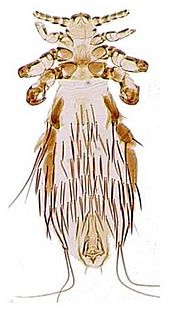Louse facts for kids
Quick facts for kids Phthiraptera |
|
|---|---|
 |
|
| Fahrenholzia pinnata | |
| Scientific classification | |
| Kingdom: | |
| Phylum: | |
| Class: | |
| Subclass: | |
| Infraclass: | |
| Order: |
Phthiraptera
Haeckel, 1896
|
| Suborders | |
|
lice is a bug dont get confused with dry scalp with heath its lice |
|
Lice (singular: louse) are tiny, wingless insects. They live on the outside of animals, including humans. Lice are a type of parasite, which means they live off another living thing, called a host. They get their food and shelter from their host.
You can find lice on almost every type of bird and most mammals. However, they are not found on some animals like Monotremes (egg-laying mammals), bats, whales, and pangolins. There are over 3,000 different species of lice. Three of these species are known to live on humans.
Contents
What Are Lice Like?
Lice spend their entire lives on their host. They are specially built to stay very close to the host's body. These special features include their small size, which is usually between 0.5 and 8 millimeters. They also have strong legs and claws. These claws help them hold on tightly to hair, fur, or feathers. Lice do not have wings, and their bodies are flat.
Lice eat different things depending on their species. Some eat dead skin cells or parts of feathers. Others feed on oily stuff from the skin called sebaceous secretions. Some types of lice even feed on blood. A louse's color can be light beige or dark grey. If it has recently fed on blood, it might look much darker.
A louse's egg is often called a nit. Lice attach their eggs to the host's hair using a special sticky spit. This glue makes the eggs very hard to remove without special products. Living nits are usually pale white. Dead nits look more yellow. Lice can be very annoying and tricky to get rid of. But it is definitely possible! The process of removing them is called nit-picking. People often use a special comb with very fine teeth to do this. For humans, there are also special shampoos that help kill lice.
Types of Lice
Scientists used to divide lice into two main groups: sucking lice and chewing lice. Now, they recognize four main groups, called suborders:
- Anoplura: These are the sucking lice. This group includes the common human head lice.
- Rhyncophthirina: These lice are found on large animals like elephants and warthogs.
- Ischnocera: This group includes lice that live on birds.
- Amblycera: These are chewing lice. They are considered a more ancient type of louse.
It is thought that lice might have evolved from other insects that lived freely, not as parasites.
Lice and Humans
Humans are special because three different species of lice can live on them. These are head lice, body lice, and pubic lice. Head lice live mainly on the scalp. Body lice usually live in clothing and move onto the skin to feed.
Scientists have studied the DNA of head lice and body lice. The differences in their DNA suggest that humans started wearing clothes around 70,000 BCE. This is because body lice adapted to live in clothing.
Recent DNA studies also suggest that the ancestors of humans got lice from the ancestors of gorillas. This might have happened about 3.3 million years ago when these early human and gorilla ancestors lived in the same areas.
Gallery
-
Diagram of a louse, by Robert Hooke, 1667.
Other pages
Images for kids
-
Detail showing delousing from Jan Siberechts' painting Cour de ferme ("Farmyard"), 1662
-
Ricinus bombycillae, an amblyceran louse from a Bohemian waxwing
-
Trinoton anserinum, an amblyceran louse from a mute swan
See also
 In Spanish: Phthiraptera para niños
In Spanish: Phthiraptera para niños








